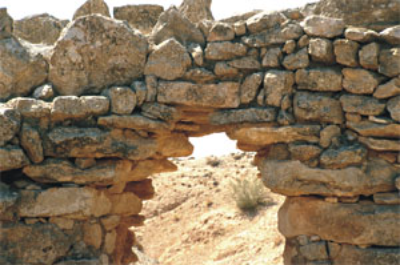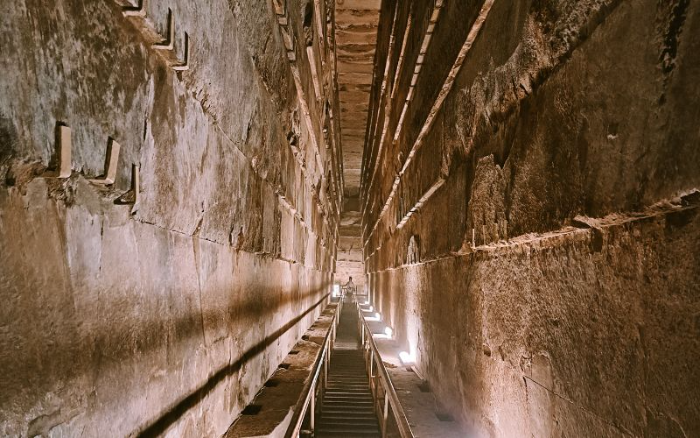
Roman circular arcs

constructing circular arcs
In their constructions the Roman often used circular arcs. The great advantage of this type of construction is that only pressure occurs instead of pressure and traction. So stone can be used in its full strength, not as in architraves. With less material Roman could cross larger spans.

cantilever constructions
The oldest gates in stone were constructed by protruding the layers bit by bit, as you can do with Lego stones. THis principle is called a cantilever construction.

This principle was also used to construct large corridors inside the Egyptian piramids to reduce the span width.

from tier to tier
A Practical Introduction to Muqarnas
On Youtube illustreert Eric Broug illustrates how to make a muqarnas model out of board paper. You discover how muqarnas are formed from tier to tier. On a frontal look you see a construction of cells. When you look on it from above you see a 2D tiling.
In following applet you can follow the construction of the capital of the film. In the graphic left you can see the top view zie je het bovenzicht. Right you can drag and rotate the 3D-view to look at the capital.
2 layers
Next construction comes from the website of [url=http://www.henkhietbrink.nl/]Henk Hietbrink[/url], in which he introduces muqarnas in workshops.
La Zisa
You can find rare examples of muqarnas outside of the Islam world in Palermo (Sicily). [br]A spledid exapmle is a niche in the central hall of the Castello della Zisa, the 12[sup]th[/sup] centure summer residence of the Norman kings.[br]Vincenza Garofaldo describes in detail this muqarnad and situates it with regard to the practices in the western and the eastern Islamic regions in the article [url=https://www.jstor.org/stable/25769702?seq=1]https://www.jstor.org/stable/25769702?seq=1]A methodology for studying Muqarnas: the extant Examples in Palermo[/url].

The muqarnas in la Zisa counts 12 tiers. [br]It's usual to use just a limited number of element types in a muqarnas. Often in one tier you can find just one element type. But in the muqarnas in la Zisa you can count not less than 8 different elements, combined in a complicated way and mixed over different tiers.[br][br]At first we'll take a look at these different types of elements, than we observe how they are combined in the muqarnas.

links
[list][*]On the website of the [url=http://www.sigd.org/resources/muqarnas/]School of Islamic Geometric Design[/url] you can find lots of materials on the construction of muqarnas and links to other sites.[/*][*]Eric Broug made a nice film on making muqarnas out of [url=https://www.youtube.com/watch?v=GH7N38vX-6I]cardboard[/url].[/*][/list]
[list][*]Thé database of muqarnas with many 2D schemes is the website of [url=http://www.shiro1000.jp/muqarnas/default.htm]Shiro Takahashi[/url].[/*][/list]

[list][*]Very nice is how [url=http://www.henkhietbrink.nl]Henk Hietbrink[/url] illustrates on his website how in workshops he works with a 3D printer, cut-out shapes and a STL viewer to show 3D animations in analysing many examples of muqarnas.[/*][/list]

Getty Publications put the book The Topkapi Scroll - Geometry and Ornament in Islamic Architecture of Gülrü Necipoglu online. You can legally download it at [url=https://www.getty.edu/publications/virtuallibrary/9780892363353.html]Getty Publications[/url]. Besides high quality reproductions of thé historical written source of islamic patterns and muqarnas, you get a standard work that situates the scroll into its historical-cultural-scientifical context.

Who's looking for supplementary mathematical-scientifical information surely will find what he's looking for in some publications, that you can find online as pdf-documents.[br][br][list][*]Don't the dissertation of Silvia Harmsen: [br][url=https://archiv.ub.uni-heidelberg.de/volltextserver/7047/]Algorithmic Computer Reconstructions of Stalactite Vaults - Muqarnas - in Islamic Architecture[/url].[br][/*][*]Very interesting too is the work of Yvonne Dold-Samplonius: [br][url=http://www.jphogendijk.nl/arabsci/Dold1.pdf]Practical Arabic Mathematics: Measuring the Muqarnas by al-Kashi[/url][/*][/list]
